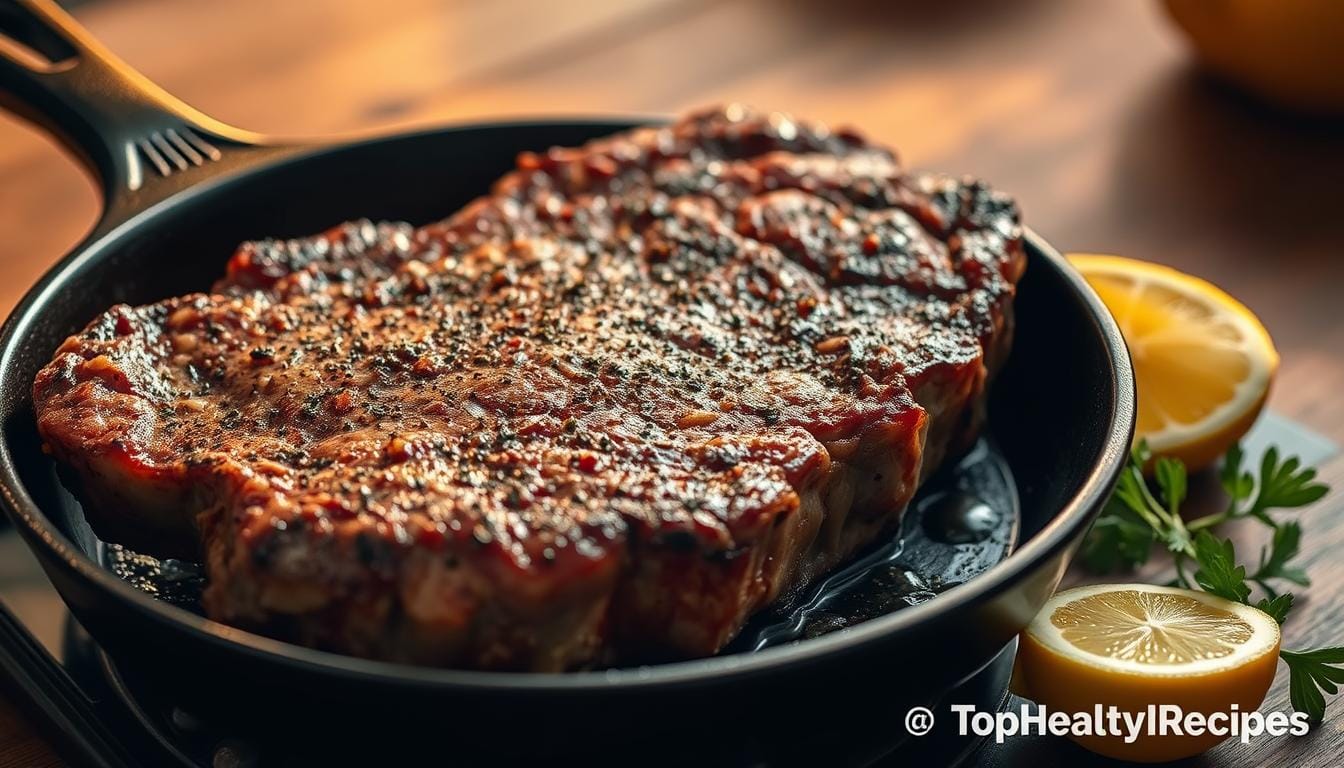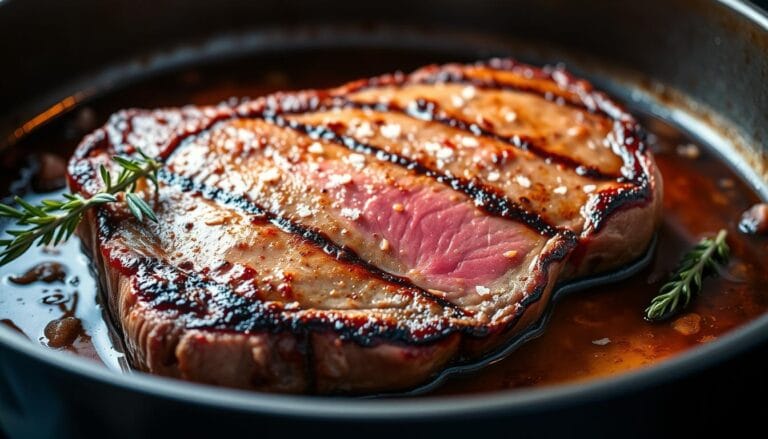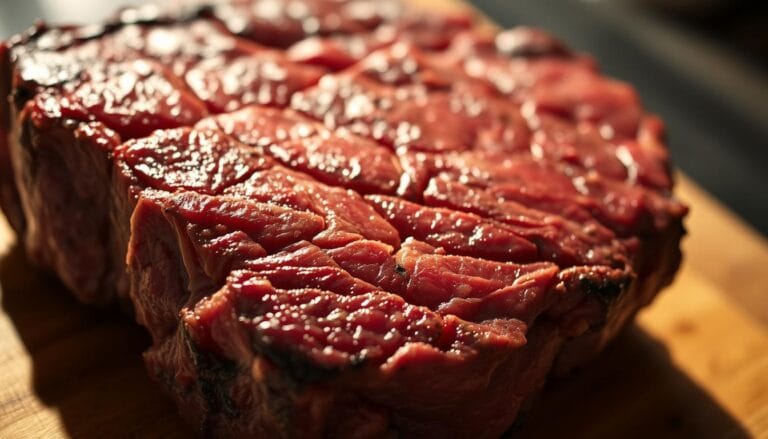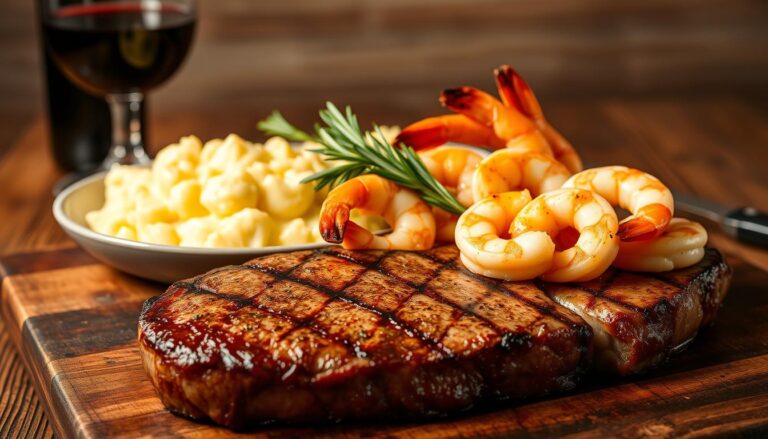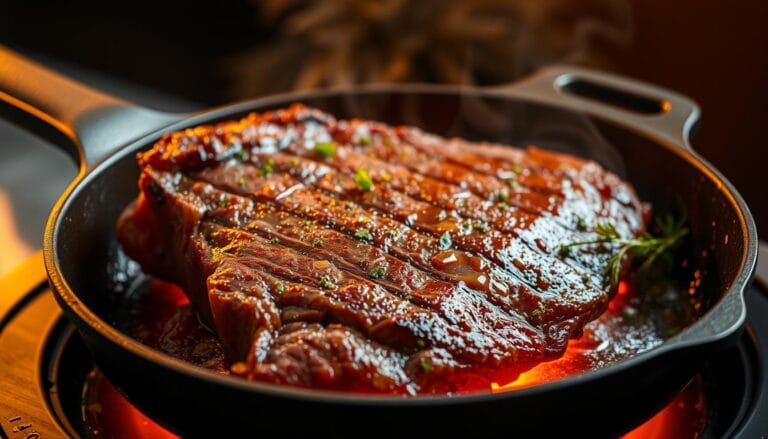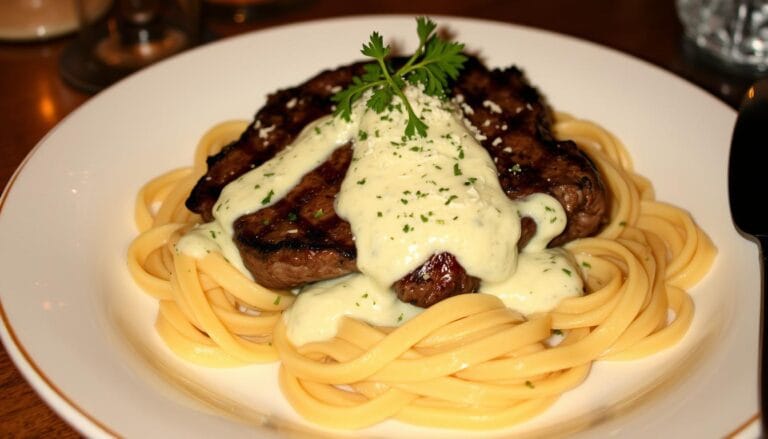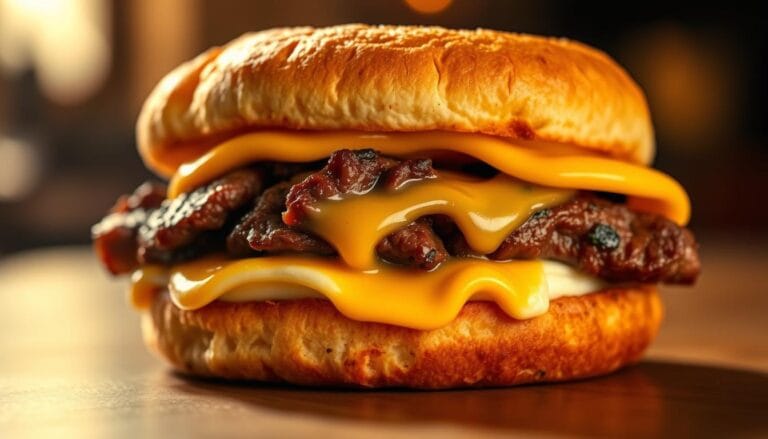How to Cook Strip Steak on the Stove
Table of Contents
How to Cook Strip Steak on the Stove for a Perfect Crust
There’s something magical about slicing into a perfectly seared steak. The crackle of the crust gives way to tender, rosy meat inside. I’ll never forget the first time I made my favorite steakhouse meal at home.
The sizzle of butter hitting the pan filled my kitchen with aroma. And the triumph of realizing I didn’t need a fancy grill to make restaurant-quality steak.
Stovetop searing unlocks flavors you can’t get with other methods. Cast iron’s intense, even heat creates that caramelized exterior chefs love. It also locks in juices better than open flames.
We’ll show you how to choose the right cuts. Look for USDA Prime or Choice with marbling like snowflakes in the meat. And why thickness matters more than weight.
You’ll learn the three pillars of steak success: preheating technique, oil selection, and resting time. Did you know a 5-minute pause after cooking can boost juiciness by 20%? We’ve tested every variable, from salt timing to butter basting, so you get consistent perfection without guesswork.
Key Takeaways
- Choose USDA Prime or Choice grades for optimal marbling and tenderness
- Preheat your pan 5-7 minutes to achieve professional-level searing
- Use high-smoke-point oils like avocado or grapeseed for safer cooking
- Monitor internal temperature with a meat thermometer for precise doneness
- Rest meat 5-10 minutes before slicing to redistribute juices evenly
Understanding Strip Steak Cuts
Before you start cooking NY strip steak, knowing your cut is key. This section explains the anatomy, flavor, and quality grades. These factors turn good steak into restaurant-quality results.
What is a Strip Steak?
The strip steak comes from the longissimus dorsi muscle, along the cow’s spine. It’s lean yet tender. There are two main types:
- New York Strip: Trimmed, with a rectangular shape for even cooking
- Kansas City Strip: Has a larger fat cap and curved bone-in edge for richer flavor
Butchers suggest 1.5-2 inch thick cuts for stovetop cooking. Thinner steaks might overcook. Thicker ones need more heat.
Flavor Profile of Strip Steak
Strip steak has a bold beefy taste with nutty undertones. Its texture is tender yet chewy. This is thanks to:
- Moderate marbling (fat streaks within the muscle)
- Minimal connective tissue compared to tougher cuts
“The longissimus muscle works hard enough to develop flavor but stays tender – it’s the Goldilocks zone of steak cuts.”
Best Grades of Strip Steak
USDA grades affect how your steak cooks and tastes. Here’s what you need to know:
| Grade | Marbling | Best For |
|---|---|---|
| Prime | Abundant | High-heat searing |
| Choice | Moderate | Everyday cooking |
| Select | Minimal | Marinating |
Prime grades create a great crust when cooking NY strip steak. Choice offers better value for everyday meals.
Preparing Your Strip Steak
Great steak starts long before it hits the pan. Proper preparation ensures maximum flavor and that signature crust you’re after. Let’s break down the three essential steps that separate good results from exceptional ones.
Choosing the Right Cut
Look for steaks at least 1.25 inches thick – thin cuts overcook before developing a proper crust. Opt for USDA Choice or Prime grades with visible marbling (those white fat streaks). Marbling melts during cooking, keeping your steak juicy when you cook strip steak on the stove.
Thawing Frozen Steak Properly
Never cook frozen steak directly. Follow this refrigerator method:
- Place frozen steak on a plate in the fridge 24 hours before cooking
- Pat dry with paper towels before seasoning
- Discard any liquid in the plate
Avoid rinsing: Water spreads bacteria and washes away natural juices. Paper towels remove surface moisture better than cloth.
Dry Brining for Flavor
Salt works magic when given time. Here’s why dry brining beats last-minute seasoning:
- Salt penetrates meat fibers, retaining moisture during cooking
- Surface drying creates better browning
- Enhances natural beef flavor without overpowering
Apply coarse salt 24 hours before cooking. Leave steak uncovered on a rack in the fridge. Skip aluminum foil wraps – they trap moisture and ruin your crust.
Essential Tools for Cooking
Your kitchen tools are key to cooking a perfect NY strip steak. While passion is important, the right tools ensure great results every time. Let’s look at the must-haves for steak cooking.
Recommended Cookware
For searing steak, heavy-bottomed pans are the best. Cast iron and carbon steel skillets are top choices. Each has its own benefits:
| Material | Heat Retention | Best For | Maintenance |
|---|---|---|---|
| Cast Iron | Excellent | Long sears & oven finishing | Season regularly |
| Carbon Steel | Good | Quick heating & lighter weight | Wipe dry immediately |
All-Clad D3 pans are a third option. They use stainless steel with aluminum core for even heating. They’re great for those who want durability without the seasoning trouble.
Essential Utensils
Every steak cook needs three tools:
- Fish spatula: Its thin edge slides under steaks without tearing the crust.
- Tongs with silicone grips: Protect your cookware while flipping meat confidently.
- Basting spoon: For butter basting without splashing hot oil.
Meat Thermometer Importance
Don’t guess the doneness of your steak. A ThermoPro instant-read thermometer gives you the exact internal temperature in seconds. Here’s why it’s so important:
- Avoids overcooking (125°F = rare, 135°F = medium-rare)
- Works for thick cuts and uneven shapes
- Calibrates automatically for accuracy
Pro tip: Insert the probe sideways into the steak’s center for the truest reading.
Seasoning Your Strip Steak
Seasoning turns a good New York strip steak into a memorable meal. It brings out the meat’s natural flavors. Salt and pepper are the basics, but rubs and marinades add more depth. Let’s look at three ways to make your new york strip steak recipe stand out without hiding the meat’s taste.
Simple Seasoning Techniques
Classic combinations work best for high-quality cuts. Begin with coarse sea salt and freshly cracked black pepper. They create a tasty crust. For more flavor, try these simple rubs:
| Method | Ingredients | Best For |
|---|---|---|
| Salt & Pepper | 1 tbsp salt, 1 tsp pepper | Traditionalists |
| Coffee Rub | 2 tsp coffee grounds, 1 tsp smoked paprika | Smoky depth |
| Herb Crust | Rosemary, thyme, garlic powder | Earthy aroma |
Experimenting With Marinades
Acidic marinades tenderize the steak, but timing is key. Marinate for 30 minutes maximum. Longer marinating can make the steak mushy. For overnight marinating, use oil-based mixtures with:
- Olive oil + minced garlic
- Soy sauce + brown sugar
- Yogurt + cumin (for lean cuts)
Fresh Herbs and Spices
Make a garlic-thyme compound butter to top your steak. Mix:
- 1/2 cup softened unsalted butter
- 2 minced garlic cloves
- 1 tbsp fresh thyme leaves
- 1/4 tsp sea salt
Roll into parchment paper and chill. Slice a patty to melt over the steak during resting. The herbs infuse flavor and keep the meat juicy.
Prepping Your Stove
Mastering stovetop cooking starts with precise heat control and pan preparation. The right setup ensures your strip steak develops that golden crust while staying juicy inside. Let’s break down three critical steps to optimize your cooking surface.
Choosing the Right Heat Level
High heat (400-450°F) works best for searing, but not all oils can handle it. Avocado oil has a smoke point of 520°F, making it ideal for intense heat. Ghee (485°F) adds rich flavor but burns faster than refined oils.
| Oil/Fat | Smoke Point | Best For | Flavor Impact |
|---|---|---|---|
| Avocado Oil | 520°F | High-heat searing | Neutral |
| Ghee | 485°F | Medium-high heat | Nutty, rich |
| Extra Virgin Olive Oil | 375°F | Finishing/post-cook | Fruity |
Knowing When the Pan is Ready
Try the water droplet test: Flick a few drops onto the dry pan. If they sizzle and evaporate instantly, it’s too hot. Perfect readiness? Drops should dance like mercury before vaporizing in 2-3 seconds.
Adding Oil: Timing and Quantity
Pour oil after preheating – cold oil in a cold pan leads to uneven cooking. Use 1-2 tablespoons max. Swirl clockwise, then counter-clockwise to coat the surface. This prevents hot spots that could burn your steak.
Pro Tip: Cook one steak at a time if using small pans. Overcrowding drops the pan temperature by 50-75°F, resulting in steamed meat instead of caramelized crust.
Searing Your Strip Steak
Mastering the sear makes your strip steak truly special. It creates a crust that keeps juices in and adds deep flavors. This happens through the Maillard reaction, where amino acids and sugars caramelize at high heat.
The Searing Process Explained
Begin with a smoking-hot cast iron skillet (450°F, as checked with an infrared thermometer). Put your seasoned steak in the dry pan and press it down with a bacon press. This helps brown the steak evenly.
Here’s a timeline for the best crust:
- 0-2 minutes: The steak starts to sear and gets a golden-brown base layer.
- 2-4 minutes: The crust darkens as the steak’s internal temperature hits 90°F.
- 4-6 minutes: The final sear phase brings the steak to 110°F internally.
Importance of Patience
Don’t check the steak for the first 2 minutes. Checking too soon can ruin the crust. Chefs suggest these flipping methods:
| Method | Pros | Cons |
|---|---|---|
| Single Flip | Better crust formation | Requires precise timing |
| Frequent Flips | More even cooking | Slows crust development |
Techniques for Even Searing
Turn the steak 45° halfway through each side’s cooking time. This creates crosshatch marks. For thicker cuts:
- Sear the edges for 30 seconds each using tongs.
- Baste with butter during the final minute.
- Check the internal temperature in multiple spots.
Remember, your steak will warm up by 5-10°F while it rests. Take it off the heat when it’s at 110°F for medium-rare.
Cooking to Desired Doneness
Mastering steak doneness is key to becoming a pro in the kitchen. Whether you like your steak rare or fully cooked, getting it right is all about precision. Let’s explore the science of temperature control and why being patient is important.
Understanding Steak Doneness Levels
Internal temperature is your compass for perfect results. Here’s a quick guide:
| Doneness | Temperature | Description |
|---|---|---|
| Rare | 125°F | Cool red center, ultra-juicy |
| Medium Rare | 135°F | Warm red center, ideal tenderness |
| Medium | 145°F | Pink throughout, balanced texture |
Steak keeps cooking after it’s removed from heat (carryover cooking). Take it off the heat 5°F before your target for the best taste.
Using a Meat Thermometer
Don’t guess the doneness. Follow these steps:
- Insert the probe sideways into the steak’s thickest part
- Avoid touching bone or fat pockets
- Wait 3 seconds for an accurate reading
Chef’s tip:
“Treat your thermometer like a steering wheel – without it, you’re just driving blind.”
Resting Your Steak After Cooking
Resting lets juices spread evenly. A 1-inch thick steak needs 5-7 minutes, while thicker cuts need up to 10 minutes. Skip this step, and you’ll lose 30-40% of the juices when slicing.
While resting, the steak’s internal temperature goes up 5-10°F. So, a steak pulled at 130°F will naturally reach 135°F (medium rare). Patience is rewarded with every juicy bite.
Adding Flavor with Butter
Butter is more than just an ingredient; it’s a flavor booster for your steak. It creates a rich, golden crust and adds aromatic depth. Here’s how to use butter to enhance your New York strip steak without burning it or overpowering the meat.
When to Add Butter
Timing is key. Add butter after searing but before finishing the steak. Wait until the pan cools to medium heat, around 300–325°F. This prevents the milk solids from burning, which can make the steak taste bitter.
Use clarified butter for high-heat cooking. It has a higher smoke point (450°F vs. regular butter’s 350°F) and lets you baste longer without risk. For a standard New York strip steak recipe, use 2–3 tablespoons.
Aromatics to Enhance Flavor
Pair butter with fresh aromatics to build complexity. A classic blend includes:
| Ingredient | Quantity | Role |
|---|---|---|
| Garlic cloves | 3–4 (smashed) | Adds earthy sweetness |
| Rosemary sprigs | 2 | Provides piney freshness |
| Shallot slices | 1 medium | Offers mild onion flavor |
Toss these into the butter as it melts. Let them sizzle gently—overcooking can make garlic bitter.
Basting Techniques
Use the tilt-and-baste method for even flavor distribution:
- Tilt the pan slightly to pool the melted butter.
- Spoon the hot butter over the steak continuously for 1–2 minutes.
- Flip the steak and repeat, ensuring both sides absorb the infused butter.
This technique locks in juices while coating the meat with aromatic oils. For best results, use a metal spoon—it withstands high heat better than silicone.
Slicing Your Strip Steak
How you slice your cooked NY strip steak can make a big difference. It can turn a chewy meal into a tender delight. The right cutting technique keeps the steak soft, makes it look great, and brings out the flavor in every bite. Let’s explore the best ways to slice your steak.
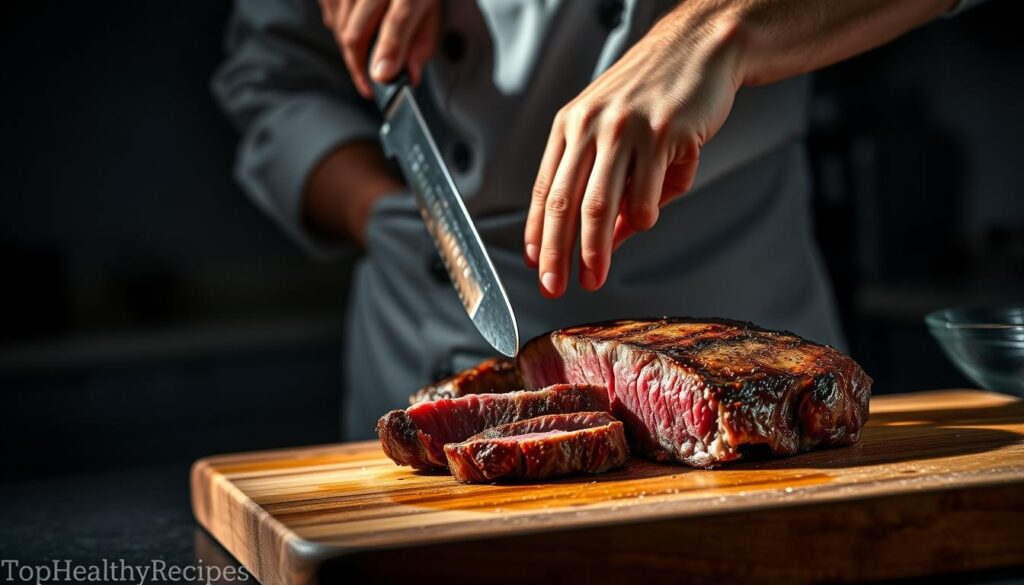
Proper Slicing Techniques
First, use a sharp knife. Dull knives can tear the meat instead of cutting it cleanly. Hold your knife at a 45-degree angle and move it smoothly. Here’s how to get the best results:
- Cut slices ¼ to ½ inch thick
- Wipe the knife blade between cuts
- Use a Granton-edge knife (with oval hollows) to prevent sticking
Against the Grain vs. With the Grain
Look closely at the steak’s surface to see the muscle fibers’ direction. Cutting against the grain is key for tender bites:
| Method | Result | Best For |
|---|---|---|
| Against the grain | Shorter muscle fibers = tender bites | NY strip, flank steak |
| With the grain | Long fibers = chewier texture | Carving showpieces |
A Santoku knife is great for this. Its curved blade makes cutting through tough fibers easy.
Presentation Tips for Serving
Arrange the slices in a cascading pattern on a warmed platter. This keeps the steak warm. Add some flair with:
- Board sauces drizzled around the meat
- Rosemary sprigs or microgreens as garnish
- Coarse sea salt sprinkled along the platter’s edge
Pro tip: Place lemon wedges under the steak slices. Their acidity adds a nice touch to the beef’s richness.
Pairing Sides with Strip Steak
A perfectly cooked strip steak needs great sides and drinks. The right choices make your meal special. Let’s look at classic pairings, wine matches, and new twists that bring out the steak’s flavors.
Classic Side Dishes
Roasted garlic mashed potatoes are a classic choice for strip steak. Cook them with your New York strip in the oven to save time. Roast garlic cloves while the steak rests, then mash them into creamy potatoes. Pair with:
| Side Dish | Prep Time | Cooking Method |
|---|---|---|
| Sautéed asparagus | 10 mins | Stovetop |
| Creamed spinach | 15 mins | Oven-to-table bake |
| Yorkshire pudding | 20 mins | Oven |
Wine Pairing Suggestions
A Napa Valley Cabernet Sauvignon pairs well with the steak’s richness. For lighter options, try these pairings:
| Wine Type | Flavor Notes | Pairing Reason |
|---|---|---|
| Malbec | Plum, black cherry | Balances charred crust |
| Zinfandel | Spicy, jammy | Complements pepper rubs |
| Syrah | Smoky, earthy | Enhances herb crusts |
Creative Flavor Combinations
Try miso-glazed carrots—roast them in the oven while the steak rests. Drizzle with honey-miso sauce for sweetness. Here are some modern twists:
| Side | Key Ingredient | Flavor Impact |
|---|---|---|
| Kimchi fried rice | Fermented cabbage | Adds tangy heat |
| Chimichurri potatoes | Fresh parsley | Bright, herbal contrast |
| Blue cheese polenta | Gorgonzola | Rich, creamy finish |
Plan your sides well: Start oven dishes when searing the steak. Use the steak’s resting time (8–10 minutes) to finish roasted veggies or warm bread. This way, everything is hot and ready when it’s time to eat.
Storing Leftover Strip Steak
Turn your leftover New York strip into new dishes with these storage and reuse tips. Proper handling keeps flavor and texture fresh. It also opens doors to creative meals. Let’s explore how to keep your steak fresh, reheat it well, and repurpose it.
Best Practices for Refrigeration
Cool your steak to room temperature within 2 hours of cooking before refrigerating. For maximum freshness:
- Vacuum sealing removes air, preventing freezer burn for up to 3 months
- Parchment wrapping works for short-term storage (3-4 days) – wrap tightly and place in airtight containers
Label packages with dates to track freshness. Never leave cooked steak at room temperature for more than 2 hours.
Reheating Techniques
Revive your New York strip without drying it out:
- Sous vide method: Set water bath to 130°F (54°C), seal steak in bag, and heat for 45 minutes
- Oven approach: Place steak on rack over baking sheet at 250°F (120°C) until internal temp reaches 110°F (43°C)
Always finish with a quick sear in a hot pan to restore crust texture.
Creative Uses for Leftovers
Turn yesterday’s steak into today’s star ingredient:
- Steak hash with potatoes: Dice steak and pan-fry with cubed potatoes, onions, and paprika – finish in the oven for crispy texture
- Philly cheesesteak egg rolls: Combine thin-sliced steak, peppers, onions, and provolone in wrappers; bake at 400°F (204°C) until golden
These ideas work well with New York strip’s robust flavor. Leftover steak also elevates salads, sandwiches, or breakfast scrambles.
Troubleshooting Common Issues
Even the most skilled cooks can run into problems when cooking strip steak. Mistakes can happen whether you’re using a stove or grill. But, with the right fixes, you can turn these errors into chances to learn and improve.
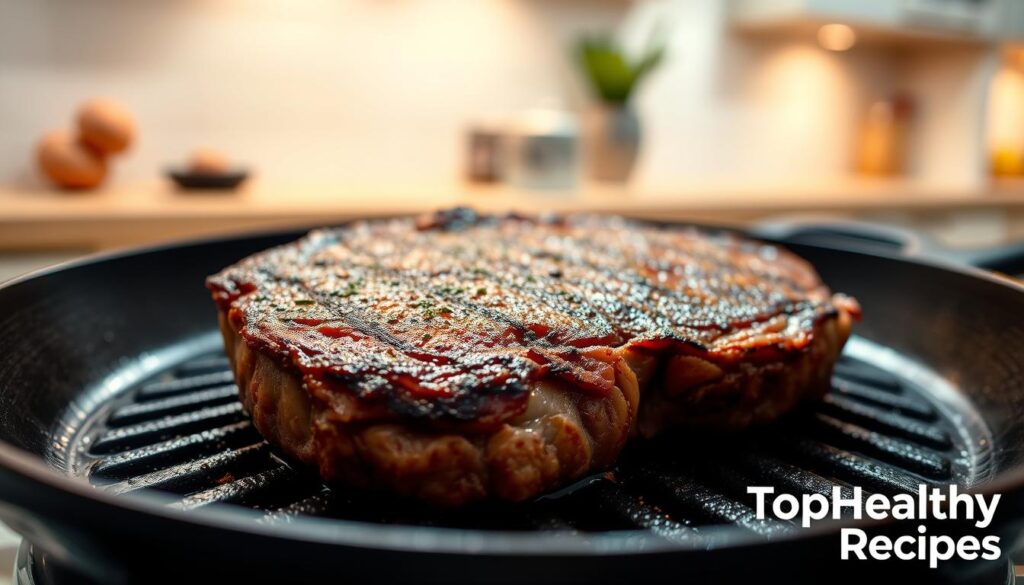
What if Your Steak is Tough?
A chewy steak can be due to undercooking or using a lower-quality cut. Here are some ways to fix it:
- Velveting with cornstarch: Cut the meat thinly and coat it in a cornstarch-water mix (1:2 ratio). Then, stir-fry it quickly to make it tender.
- Braising in broth: Simmer the steak in beef broth with onions and garlic for 45–60 minutes. This breaks down the tough fibers.
- Reverse sear revival: Cook the tough steak in a 275°F oven for 10–15 minutes. Then, quickly sear it to relax the fibers.
Fixing Overcooked Steak
Even overcooked steak can be saved with the right adjustments:
- Slice it thinly and use it in tacos or salads to hide its dryness.
- Drench it in a sauce like chimichurri or béarnaise. This adds moisture and flavor.
- Stove vs. grill tip: Stove-cooked steak cooks faster because it’s in direct contact with metal. Grill users should watch out for flare-ups that can make the steak unevenly cooked.
Adjusting Seasoning Mistakes
Save over-salted or over-spiced steak with this flavor balance guide:
| Issue | Quick Fix | Best For |
|---|---|---|
| Too salty | Rinse briefly, pat dry, add lemon juice | Stove-seared steak |
| Too spicy | Serve with yogurt sauce or honey glaze | Grilled steak |
| Bland flavor | Sprinkle flaky salt after slicing | Both methods |
Grilled meats soak up smoke flavors deeply. So, use lighter rubs compared to stove cooking. For stove cooking, season in layers: salt before cooking, herbs after searing.
Tips for Cooking Like a Pro
Mastering strip steak is all about technique, creativity, and top-notch ingredients. Whether you’re searing on the stove or getting grill marks, these tips will help you improve.
Learning from Professional Chefs
Michelin-starred chefs stress the importance of controlling heat for the perfect doneness. Chef Michael Mina says:
“Treat your pan like a dance floor – sear aggressively at first, then reduce heat to let the steak finish gracefully.”
Here’s a comparison of stovetop and grill methods:
| Method | Heat Source | Texture | Best For |
|---|---|---|---|
| Stovetop | Cast iron skillet | Uniform crust | Indoor cooking |
| Grill | Charcoal/gas flames | Charred marks | Smoky flavor |
Experimenting with Cooking Methods
Try combining methods like smoker-to-skillet finishes for extra flavor. Here’s a recipe:
- Smoke steak at 225°F for 45 minutes
- Sear in a blazing-hot skillet with avocado oil
- Baste with garlic-thyme butter
Chef Stephanie Izard suggests:
“Reverse searing works wonders for thicker cuts – low oven heat first, then a quick pan finish.”
Using High-Quality Ingredients
Snake River Farms American Wagyu is known for its amazing marbling. Look for USDA Prime or dry-aged options. Grass-fed beef is leaner, while grain-finished cuts taste richer.
Use finishing salts like Himalayan pink or smoked Maldon to enhance flavor. Fresh herbs like rosemary or tarragon add a nice aroma when basting.
Enjoying Your Perfect Strip Steak
Learning to cook strip steak on the stove opens up new ways to enjoy meals. Add a touch of creativity with how you present and flavor your steak. This turns a simple meal into a memorable experience.
Serving Suggestions for Every Occasion
For a special anniversary dinner, try medium-rare strip steak with truffle mashed potatoes and roasted asparagus. Add a red wine reduction and pair with a full-bodied Cabernet Sauvignon. For game nights, cut the steak into strips for tacos with charred corn salsa and lime crema. Enjoy with cold beer or smoky mezcal cocktails.
Themed Pairings and Tablescapes
For a Tuscan vibe, top your steak with rosemary-garlic butter and serve with cannellini beans and Chianti. Use warm string lights, terra-cotta plates, and olive wood boards. For a modern touch, plate the steak on white marble with microgreens and Malbec under soft candlelight.
Family-Friendly Adaptations
Make leftover strip steak into steak fingers that kids will love. Slice the meat, dip in seasoned flour and egg, then fry until crispy. Serve with honey mustard or barbecue sauce. Add sweet potato fries and roasted broccoli for a balanced meal.
Whether it’s a big celebration or a simple weeknight dinner, your stovetop strip steak shines. Try global flavors like Korean gochujang glaze or Argentinian chimichurri. Use quality serveware like cast iron skillets or slate platters to keep the meat warm. Share your dishes on #PerfectStripSteak to inspire others to cook strip steak on the stove.
FAQ
What’s the best way to achieve a restaurant-quality crust on strip steak?
How do I choose between USDA Prime and Choice grades for strip steak?
Can I cook a frozen strip steak directly on the stove?
Why is a meat thermometer critical for cooking strip steak?
Should I marinate strip steak before cooking it on the stove?
How do I prevent butter from burning when basting the steak?
What’s the correct way to slice strip steak for maximum tenderness?
Can I finish cooking a thick strip steak in the oven after searing?
How long should I rest strip steak before serving?
What’s the best oil for searing strip steak on the stove?
For more cooking tips, stay connected with us. We also recommend the cookbook Skinnytaste Simple: Easy, Healthy Recipes with 7 Ingredients or Fewer
For more Recipes about Steak ?
Did You try our recipe ?
There are no reviews yet. Be the first one to write one.
